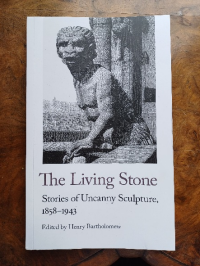The Living Stone, Stories of Uncanny Sculpture 1858 – 1943 is the ninth offering in the Weird Series from Handheld Press (October 2023). Within its pages are seventeen supernatural stories of sculpted stone. Many are by well known authors such as E. F. Benson, Oliver Onions, Edith Wharton, H. P. Lovecraft and Arthur Machen. The stories have been brought together by Henry Bartholomew, a specialist in 19th and 20th century supernatural fiction.
You will not find Nesbit’s ‘Man-size in Marble’ or Counselman’s ‘The Black Stone Statue’ here as, acknowledged in the introduction, they have been previously published in British Weird and Women’s Weird 2 by Handheld Press.
This collection is drawn from the uncanniness of sculpture, the almost mystical transformation of shapeless stone into an identifiable form. Here stone is animated into life but there is also the reverse transformation of flesh which is petrified and made stone.
For those who love a good gargoyle there are two stories: ‘Master Sacristan Eberhart’ by Sabine Baring-Gould and ‘The Maker of Gargoyles’ by Clark Ashton Smith. The former is a rather sweet tale of the attachment between man and stone, the latter is a story of stone animated by hate and desire, set in the medieval period in France.
A number of themes present themselves across the stories. Madness is present in more than a handful of them, with crazed sculptors in abundance. They have much in common with the character of the mad scientist, or obsessed alchemist. Some are motivated by arrogance, by the wish to preserve beauty, or to control and destroy. Some are driven to madness such as in ‘The Marble Hands’ by W. W. Fenn and ‘A Marble Woman’ by W. C. Morrow. It is also a theme in ‘Benlian’ by Oliver Onions and ‘Hypnos’ by H. P. Lovecraft, in both the living are transformed into stone.
Love is also a common theme too. In Robert W. Chambers’ ‘The Mask’, love is finally fulfilled after havoc is wreaked by a formula which can turn the living to stone. In ‘The Duchess at Prayer’ by Edith Wharton, love is the cause of the tragedy.
Other common themes in supernatural stories, such as revenge and unfinished business, are present too. In James Causey’s ‘The Statue’, an obsessed sculptor exacts revenge on a money lender who has taken his best work and in Nellie K. Blissett’s ‘The Stone Rider’, the dead man trapped within a sculpture manages to avenge his own murder.
Ancient rites, magic and sacrifice are covered in ‘The Ceremony’, a very short piece by Arthur Machen centred around a standing stone. Another megalith in ‘The Living Stone’ by E. R. Punshon seems to be responsible for mysterious disappearances in a village. In ‘The Menhir’ by N. Dennett, a village is cursed by a strangely carved pillar called the Grey Gammer and the new curate soon discovers why they must pay homage to the stone. Even more sinister stone gods are present in Eleanor Scott’s ‘At Simmel Acres Farm’.
In E. F. Benson’s ‘Bagnall Terrace’ the strange statuette of a cat brought back from Egypt attracts the attention of a mysterious neighbour. This is the only exotic story in the collection – the editor says whilst the colonies were a popular source of inspiration for supernatural writers, the xenophobic tendencies of the stories make them less palatable for today. This is a shame as, excluding those which are considered downright offensive, a little more orientalism with their air of mysterious foreign power might have added another dimension to the collection. Whilst these stories may indeed be at odds with our sensitivities today, all the tales in this collection date from the mid 19th to the mid 20th century and are therefore products of their time. For example, the treatment of ancient history here is very much in keeping with ideas prevalent at the time, which are old fashioned now.
Many in this collection also have female characters which are presented or treated in a way which is out of step with modern thinking and border on misogyny (and perhaps should be no more palatable than xenophobia). There are female victims such as in ‘The Marble Hands’ by W. W. Fenn and ‘A Marble Woman’ by W. C. Morrow. However, in one story at least, ‘The Man of Stone’ by Hazel Heald, there is a strong woman character who is courageous and clever and takes revenge on her evil husband.
Regardless, the collection is a thoroughly enjoyable read and a worthy addition to the Weird Series (with a somewhat worrying cover image).
